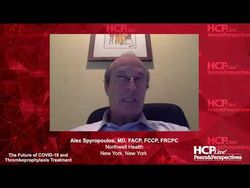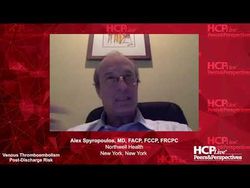Antithrombosis in Patients with COVID-19 - Episode 6
Stratifying Patients as High-Risk With COVID-19
Transcript: Gregory Piazza, MD, MS: Alex, this is a good question for you. How do we define the high-risk patients, especially in this COVID-19 [coronavirus disease 2019] setting? Are they all high-risk, and would they all fall into that medically ill, high-risk category? How much do their underlying comorbidities come into it? Or, is it really simple? Is it just that you have COVID-19, you are in the hospital, and you are high risk?
Alex Spyropoulos, MD, FACP, FCCP, FRCPC: I think, Greg, you hit the nail on the head. From what I’ve seen at this point, if you’re hospitalized in a US hospital with COVID-19, you’re at high VTE [venous thromboembolism] risk. You probably have different shades of high risk: high to very high risk, especially if you’re critically ill. But in my view, I don’t think we need to slice and dice. I think what we should assume is that these patients have a high risk of VTE, period. In my view, they should all get chemoprophylaxis, unless they have absolute contraindications.
Gregory Piazza, MD, MS: It makes sense to me. As you mentioned, the burden of VTE in these patients is high: higher if you’re in the ICU, but still high if you’re hospitalized. It’s happening, even in patients who are receiving our usual best effort, which is prophylactic anticoagulation. Do we have any sense of why patients may be resistant to our usual anticoagulant interventions?
Victor Tapson, MD, FCCP, FRCP: I’ll take a stab at it, but I would love to hear what Alex has to say. I would just say that we’ve seen other viruses, such as H1N1 [Influenza A virus]. Other viruses seem to be associated with an increased risk of VTE or hypercoagulable state. This seems to be unprecedented to me. We’re all noticing this. When someone comes into the ICU, we don’t routinely see elevated ferritin in everybody. Now we’re seeing ferritin levels of 4000 ng/mL, CRP [C-reactive protein] levels of 200 mg/L, and D-dimer levels that are 1000-fold elevated.
We all think of VTE as an inflammatory state, but not when you have a set rate of 150. We always say this. It’s an inflammatory state, but it’s not a grossly inflammatory state with fevers and high set rates. There is inflammation. But this case seems to be different. There are fevers in these patients, and we see these dramatic inflammatory markers. My thought is that there’s a lot of inflammation that ties in with thrombosis, and we’re seeing what I believe is a microvascular thrombosis picture in these patients. That’s why we’re seeing dead space ventilation, high oxygen requirements, and sometimes, not so much on the x-ray.
There are other issues, too, and I don’t mean to digress. Some of the patients we’ve had have had tons of secretions, and they even need bronchoscopic suction. I’m glad I’m not the one in there performing that, either. I think that they’re sick people with inflammation, and there may be something even more peculiar about the coagulation pathway and the DIC [disseminated intravascular coagulation] picture that Alex described. It’s not a classic DIC picture.
Transcript Edtied for Clarity



